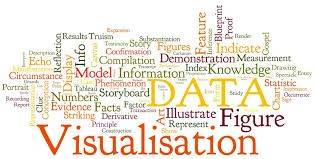Data Analytics and Visualization: Transforming Raw Data into Strategic Insights
Data analytics and visualization are very important in transforming raw data into actionable intelligence; otherwise, such an attempt is equivalent to seeing pictures without any context, which does not help businesses or organizations to make sense of complex datasets and quickly see patterns to facilitate informed decisions. Data analysis is a step by step approach like fishing: getting the data first then cleaning and transforming it before you can analyze it in ways that can be described as descriptive, diagnostic, predictive, prescriptive analytics. Visualization on the other hand makes this picture graphically visible so that it can be used further for decision making purposes: Python, R or SQL programming languages are often combined with platforms like Tableau or Power BI. Effective data analysis should have well-defined goals just like an artist who knows his target audience while choosing proper visualizations must be a deliberate process of finding the right frame for artwork. Now it needs to keep refining till information becomes understandable and doable since apart from strategic growth; innovation emanates from making meaning out of the data.
- Introduction
- Understanding Data Analytics
- The Role of Data Visualization
- Conclusion
Introduction
To any organization or business, converting raw data into smart information is very fundamental because today’s world is made of information. Data analytics and visualization are crucial for decision makers to understand large datasets easily as they can see trends that will help them make the right decisions. This article examines key principles and practices of data analytics and visualization, emphasizing their significance in offering an all-inclusive guide to practitioners seeking expertise in the area— thus empowering them with skills required to exploit the power inherent in data.
Understanding Data Analytics
Data analytics is examining the statistics, understanding patterns, and interpreting actions in our surroundings using figures and information. These include 4 primary kinds: Descriptive Data Analytics, Diagnostic Data Analytics, Predictive Data Analytics, Prescriptive Data Analytics.
Yes, KIET Ghaziabad has collaborated with various colleges and universities. The below-mentioned are KIET Ghaziabad collaborations:
| KIET Ghaziabad Collaborations and Partnerships | ||
|---|---|---|
| SWOSU- USA | - | - |
Yes, KIET Group of Institutions is good for MBA. There are 240 MBA seats in this institution. Dr Binki Shrivastava is the HOD and Professor of this institute with specialisation in Management. The MBA department has 5 professors, 3 associate professors and 14 assistant professors with specialisation in various subjects like Finance, International Business, Enterpreneurship etc. The well maintained classrooms and high proficiency labs also makes this institute first choice. With centre of excellence, good alumni network and recruiter support, this institute is good for MBA.
Descriptive Analytics
Descriptive analytics is, about summarizing data to gain insights, into what occurred. Its methods involve aggregating and mining data.
Diagnostic Analytics
Exploring analytics involves analyzing data to understand the reasons, behind occurrences. This process utilizes methods, like delving into the data uncovering insights and identifying connections.
Predictive Analytics
Using information to foresee results predictive analytics relies on statistical models and algorithms from machine learning.
Prescriptive Analytics
Prescriptive analytics offers recommendations, for achieving goals using predictions. This involves methods such, as optimization and simulation.
The Role of Data Visualization
Visualizing data involves presenting information, in image form, which simplifies the comprehension of datasets and reveals valuable insights. Clear visualization aids, in spotting trends and patterns conveying findings and improving decision making processes.
Types of Data Visualization
- Charts and Graphs: Line charts, bar graphs, and pie charts for representing data trends and comparisons.
- Heatmaps: Color-coded representations for identifying concentrations and anomalies.
- Scatter Plots: Depict relationships between two variables, highlighting correlations and outliers.
- Geospatial Maps: Visualize data across geographical locations for location-based analysis.
- Dashboards: Integrate representations to offer a thorough summary of important metrics and key performance indicators.
Tools for Data Analytics and Visualization
There are tools to assist with data analysis and visualization each providing distinct features and functions.
Data Analytics Tools
- Python and R: There are programming languages that come with libraries-like Python, which are used for experiments and machine learning. Libraries are a language's collaborator, a section of a program written to perform a specific task.
- SQL: Standard language for managing and querying relational databases.
- Excel: Widely used for data analysis and visualization, suitable for small to medium-sized datasets.
- Apache Hadoop and Spark: Frameworks for processing and analyzing large-scale data.
Data Visualization Tools
- Tableau: Leading platform for creating interactive and shareable dashboards.
- Power BI: Microsoft's business analytics tool for visualizing data and sharing insights across organizations.
- D3.js: A JavaScript library that creates engaging and interactive data visualizations, on web browsers.
- Google Data Studio: Google Data Studio is a freely available utility that enables users to convert data into personalized, visual information reports and dashboards.
Best Practices for Effective Data Analytics and Visualization
- Set the Clear Objectives: In order to get on the right path and find the right way of reaching your analysis and visualization, you must understand the concept of these objectives.
- Familiarize with the Audience: Adapt your visualization to the needs and level of intelligence of the audience.
- Check Data: Data must be validated, for analysis and visualization, to the point that the data is in good shape.
- Find the Perfect Visualization: Select the right pictures to generate the necessary data to inform the audience about the insights they need.
- Avoid Overcomplication: You can achieve upper legibility by exposing the right core messages really.
- Refine and Retest: Try to expand the visualization with respect to activities that have happened and utilize customer response and new information that has come in to come up with better data.
Conclusion
In today's era, data has acquired a new role as the driving force not only for data visualization but also for decision making and strategic planning. With new analytical tools being invented on a rapid basis and the digital world getting smart, they are come together with visualizations to grind insights out of more pieces of information; this ensures the transfer of materials into consistent narratives that affect and determine business implications. Accordingly, it enhances the ability of businesses to see through the complex datasets, thereby, recognizing the trends and patterns and ensuring better decision making with greater confidence and precision.
Inevitably, technology becomes more and more complex, so these innovations are going to be the main instruments for shifting the course of data analytics. But among so many that regard data analytics as a competitive difference and those that invest in developing their capabilities. The society definitely thrives on the maturity aspect and the quality of life that the citizen will get, which in return will also thrive in technology. For a business, the use of data doesn't happen in the operational environment only. In fact, it is a strategic necessity too.
It lets companies to realize the high value of their data and helps in transforming the organization into decision makers and make continuous improvements. For organizations looking to leverage data analytics and visualization to enable success and harden strategic objectives, investing in improving their workforce as well as investment in the correct tools is imperative.
About the Author:

News & Updates
- Top Private Medical Colleges in Delhi/NCR
- Top Government Engineering Colleges in Delhi/NCR
- Top Skill University Colleges in Delhi/NCR
- Top Pharmacy Colleges in Delhi/NCR
- Top NITs Colleges in Delhi/NCR
- Top State Public University Colleges in Delhi/NCR
- Top Private Medical Colleges in Uttar Pradesh
- Top Government Engineering Colleges in Uttar Pradesh
- B.Tech colleges in Ghaziabad
- M.Tech colleges in Ghaziabad
- B.Pharma colleges in Ghaziabad
- PG Diploma colleges in Ghaziabad
- MBA colleges in Ghaziabad
- MCA colleges in Ghaziabad
- Engineering colleges in Ghaziabad
- Business & Management Studies colleges in Ghaziabad
- Medicine & Health Sciences colleges in Ghaziabad
- IT & Software colleges in Ghaziabad
Contact Details
Address
Delhi-NCR, Ghaziabad-Meerut Road
Ghaziabad ( Uttar Pradesh)
Get details of Similar Colleges
Student Forum
Answered 3 months ago
With a General category rank of 142,000, admission to KIET Ghaziabad’s CSE (Computer Science & Engineering) through UPTAC counseling is highly unlikely.
Previous Round Closing Ranks
For General — All India quota, CSE final closing ranks were around 99,644 (Round 4, 2024).
For General — Home State quot
Answered 4 months ago
No, RGUKT (IIIT Basara): Rajiv Gandhi University of Knowledge Technology is not under CUET. The university does not accept CUET scores for admission to the courses offered. Candidates are granted admission based on the merit of Class 10/SSC or any other equivalent examination for UG courses and the
S
Contributor-Level 10
Answered 4 months ago
The minimum eligibility requirement for admission to the BTech course at SRMCEM Lucknow and KIET Ghaziabad is almost similar, in which candidates are required to complete their Class 12 from the Science stream. Moreover, both institutions also accept JEE Mains for admission to the BTech course.
Now,
K
Contributor-Level 10
Answered 4 months ago
The total tuition fee for the BTech course at SRMCEM Lucknow ranges from INR 2.4 Lacs to INR 4.1 lakh. Additionally, the tuition fee for BTech at KIET Group of Institutions ranges from INR 2.4 Lacs - INR 4.5 lakh. Hence, the tuition fee of SRMCEM Lucknow is slightly more affordable than KIET Group o
K
Contributor-Level 10
Answered 4 months ago
RGUKT (IIIT Basara): Rajiv Gandhi University of Knowledge Technologies offers three specialisations under M.Tech course to the candidates. These include- Computer Science and Engineering, Electronics and Communication Engineering, and Computational Mechanics in Mechanical Engineering. Candidates ca
S
Contributor-Level 10
Answered 4 months ago
Yes, a candidate can apply for admission at RGUKT (IIIT Basara) if Class 10 result is pending. The university may offer them provisional admission in this case. However, since admissions to the courses offered is merit-based, the candidate must submit the marksheet and certificate of Class 10 once
S
Contributor-Level 10
Answered 4 months ago
RGUKT (IIIT Basara): Rajiv Gandhi University of Knowledge Technologies offers courses to candidates in multiple specialisations. Candidates have a variety of fields to choose from. Though, it's important to consider other factors like infrastructure, faculty, curriculum, fees structure, etc. while t
S
Contributor-Level 10
Answered 4 months ago
Yes, the application form for RGUKT (IIIT Basara): Rajiv Gandhi University of Knowledge Technologies BTech admission can be rejected if the details filled by the candidate are incorrect. It can also be rejected if the candidate has not uploaded the correct documents required like marksheets, certif
S
Contributor-Level 10









Yes, KIET Group of Institutions offers a two-yearM.Techprogramme across two specialisations, namely CSE and Mechanical Engineering. The total intake for M.Tech is 18 with 12 and 6 seats allocated to CSE and Mechanical branches, respectively. Admission to both of theseM.Techcourses at KIET is subject to UPTAC counselling conducted by APJ Abdul Kalam Technical University, Lucknow.